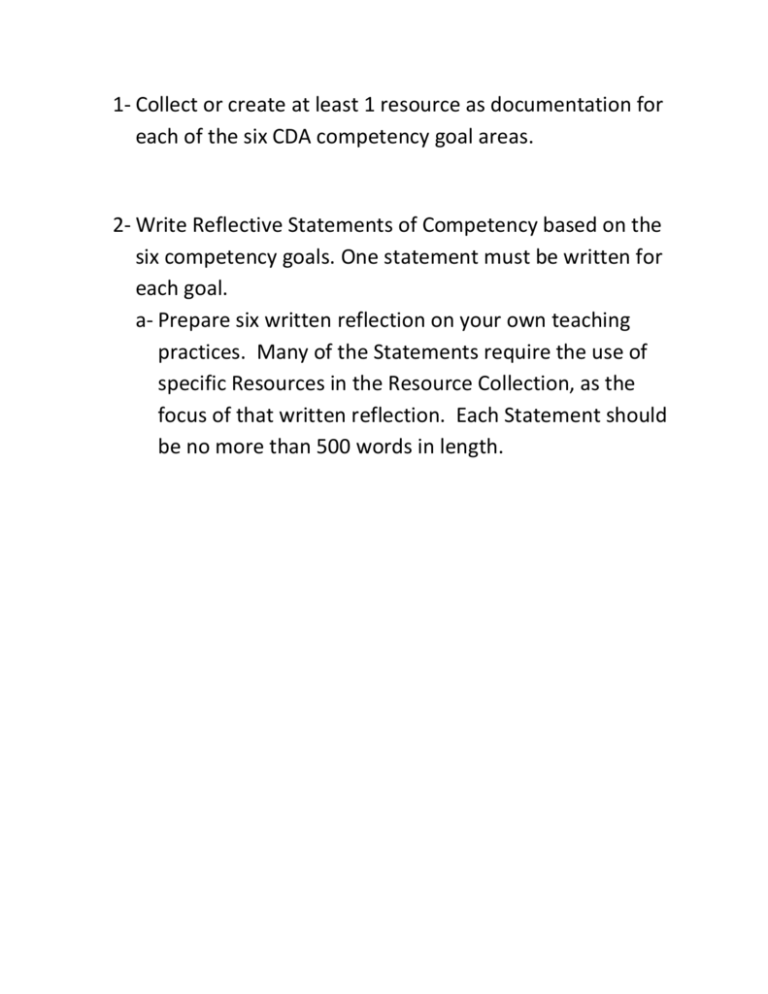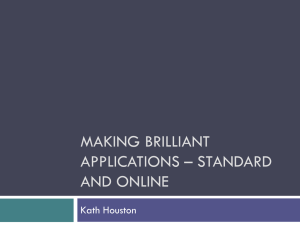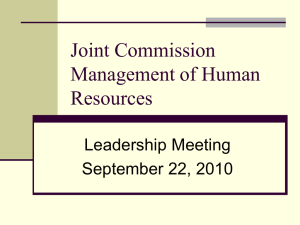Reflective Statements of Competence
advertisement

1- Collect or create at least 1 resource as documentation for each of the six CDA competency goal areas. 2- Write Reflective Statements of Competency based on the six competency goals. One statement must be written for each goal. a- Prepare six written reflection on your own teaching practices. Many of the Statements require the use of specific Resources in the Resource Collection, as the focus of that written reflection. Each Statement should be no more than 500 words in length. Reflective Statements of Competence Competence Statement I To establish and maintain a safe, healthy learning environment Begin your Reflective Statement about this Competency Goal with a paragraph describing how your teaching practices meet this Goal. Then write at least one paragraph on each of the following: CS I a Reflect on the sample menu in the Resource Collection that you participated in serving and/or designing: If you designed the menu, how does it reflect your commitment to children’s nutritional needs? If you served the menu but did not design it, what are its strengths and/or what would you change? CS I b Reflect on the room environment in which your Observation will occur: How does the room design reflect the way you believe young children learn best? If the room was not designed by you, what do you see as its strengths and/or what would you change? CS I c Reflect on the weekly plan you included in your Resource Collection. How does this plan reflect your philosophy of what young children need on a weekly basis? If the plan was not designed by you, what do you see as its strengths and/or what would you change? Competence Statement II To advance physical and intellectual competence Begin your Reflective Statement about this Competency Goal with a paragraph describing how your teaching practices meet this Goal. Then prepare at least one paragraph on each of the following: CS II a Pick one of the ten learning experiences you chose for your Resource Collection. How does this experience reflect your philosophy of how to support young children’s physical development? CS II b Pick another of the ten learning experiences you chose for your Resource Collection. How does this experience reflect your philosophy of how to support young children’s cognitive development? CS II c Pick a third learning experience you chose for your Resource Collection. How does this this experience reflect your philosophy of how to support young children’s creative development? CS II d In an additional paragraph, describe ways to promote the communication/language development among all children, including dual language learners. Competency Statement III To support social and emotional development and to provide positive guidance Begin your Reflective Statement about this Competency Goal with a paragraph describing how your teaching practices meet this Goal. Then prepare at least one paragraph on each of the following: CS III a Describe some of the ways you support the development of children’s positive self-concepts and growing social/emotional skills. CS III b Reflect on your philosophy of guiding young children’s positive behaviors. How is your professional philosophy similar or different from how you were guided as a child? How do you constructively deal with young children’s challenging behaviors? Competency Statement IV To establish positive and productive relationships with families Begin your Reflective Statement about this Competency Goal with a paragraph describing how your teaching practices meet this Goal. Then prepare at least one paragraph on each of the following: CS IV a How do you ensure that families are kept aware of what’s happening in their child’s daily/weekly life in your program? CS IV b How do you ensure that you are aware of what’s happening in each child’s home life? How does that awareness direct your teaching practices? CS IV c Reflect on the feedback you received in the Family Questionnaires you collected. Explain how the response surprised you, confirmed your own reflections about yourself and/or gave you a new goal for professional growth. Competency Statement V To ensure a well-run, purposeful program that is responsive to participant needs Begin your Reflective Statement about this Competency Goal with a paragraph describing how your teaching practices meet this Goal. CSV a Then write at least one paragraph that describes how you used the observation tool/form you included in the Resource collection. Why are observation and documentation important parts of program management? How do you ensure that you are accurately/objectively observing and tracking each child’s developmental and learning progress? Competency VI To maintain a commitment to professionalism Begin your Reflective Statement about this Competency Goal with a paragraph describing how your professional practices meet this Goal. Then: SC VI a Reflect on why you chose to become an early childhood professional. SC VI b Reflect on what you believe are the most important indicators of professionalism that you possess. After you have completed all your resources and written your statements, you will then write your Professional Philosophy Statement. The Professional Philosophy Statement is the final reflective task in the creation of your Professional Portfolio. Your goal is to summarize your professional beliefs and values about early childhood education after you have completed the professional development experience of designing your Portfolio by collecting resources and writing Reflective Statements of Competence. The Professional Philosophy Statement should be no more than two pages in length. Identify your personal values and beliefs around teaching and learning: How do you believe young children learn? Based on this, explain what you believe your role is as their teacher/caregiver. Beyond teaching and learning, reflect and write about what you believe are the other important aspects of your role in the lives of children and families. The Resource Collection RC I-1 Your valid and current certificates of completion or cards from a) any first aid course and b) an infant/child (pediatric) CPR course offered by a nationally – recognized training organization. Online training is not acceptable. RC I-2 A copy of one weekly menu. In order to complete you related Reflective Competency Statement on this topic, the menu would ideally be one that you participated in serving to and /or designing for children. RC I-3 A sample of your weekly plan that includes goals for children’s learning and development, brief descriptions of planned learning experiences, and also accommodations for children with special needs (whether for children you currently serve or may serve in the future). Indicate the age group(s) for which the plan is intended. RC II Ten learning experiences (activities), written in your own words, including one from each of the following curricular areas: RC II-1 Science/Sensory RC II-2 Language and Literacy RC II-3 Creative Arts RC II-4 Fine motor (please choose an indoor activity) RC II-5 Gross motor (please choose an outdoor activity) RC II-6 Self Concept RC II-7 Emotional Skills/ Regulation RC II-8 Social Skills RC II- 9 Mathematics RC II-10 Music (optional) RC III A bibliography that includes the titles, authors, publishers, copyright dates and short summaries of ten developmentally appropriate children’s books that you have used with young children. Each book should support a different topic related to children’s lives and challenges. Subjects you might consider addressing include: Cultural or linguistic group identity Gender Identity Children with Special Needs Separation/Divorce/Remarriage/Family Structures Phases of the cycle of life from human reproduction to death Other topics that reflect the children and families with whom you work RC IV A Family Resources Guide includes all the information you might need. At a minimum, you must include the following required items: RC IV-1 The name and contact information (phone number, web site, etc.) of a local agency that provides family counseling. RC IV-2 The name and contact information (phone number, web site, etc.) of a translation service for families whose home language is other than English as well as a service that provides American Sign Language translation. RC IV-3 The name, contact information and brief descriptions of at least two agencies in the community that provide resources and services for children disabilities (in most communities, the local school district provides these services). RC IV-4 A list of three more websites, and brief descriptions of each, that provide current information to help families understand how young children develop and learn. Include one current article for each website. Web sites must contain articles that help families understand the development and learning of 3 to 5- year- olds. At least one article must relate to child guidance. RC V Three samples of record keeping forms your use/have used. Include an accident report form, an emergency form and a completed tool/form that you have used to observe for and document a child’s developmental/learning progress (Do not include the child’s name). RC VI-1 The name and contact information of your state’s agency that is responsible for the regulation of child care centers and family child care homes. (Note: These regulations are available at the website of the National Resource Center for Health and Safety in Child Care: http://nrckids.org/STATES/states.htm) Make a copy of the sections that describe the qualification requirements for personnel (teachers, directors and assistant) and group size, adult- child ratio requirements. RC VI-2 A list of two or three early childhood associations (national, regional, state or local), including website addresses, describing the professional resources and membership opportunities they each offer. RC VI-3 Summaries of the legal requirements in your state regarding child abuse and neglect (including contact information for the appropriate agency in your state) and Mandatory Reporting Guidelines.








